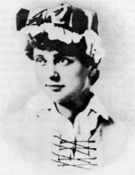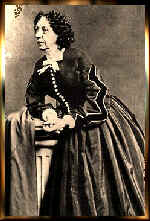|
 |
Meet Fanny Fern:
An insight into the life of Sara Payson Willis Parton, with a reprint of one of her newspaper columns.
By Naomi Michael
|
“My idea of a perfect woman is of one who can write but won’t; who knows all that the authors know and a great deal more: who can appreciate my genius and not spoil my market.”
- G.H. Lewes, English critic and novelist
Introduction
Many authors use pseudonyms. However, the author’s pen name rarely replaces the identity of the writer. In Sara Willis Parton's case, however, exactly this happened. She became known as Fanny Fern by her readers, her husband, her family, and her friends. When she died in 1872, from cancer, the only named carved on her gravestone was Fanny Fern.
Fern's Life
Fanny Fern was born on July 9, 1811, the fifth of nine children, to Nathaniel and Hannah Willis. She received a formal education at Catherine Beecher's Female Seminary in Hartford, Connecticut and then returned home to await marriage. While waiting, Fanny Fern wrote and edited articles for her father’s newspaper, The Puritan Recorder.
In 1837 she married Charles Harrington Eldridge, a bank cashier. The couple had three children: Mary, born in 1838; Grace, 1841; and Ellen, 1844. Tragedy soon struck home when Fanny Fern's little sister Ellen, died during childbirth in February1844 and in March of the same year her mother died. In 1845 her oldest daughter, Mary, died of brain fever and in 1846 her husband died of typhoid fever. Due to lack of support from either her father or her in-laws, Fanny Fern was struggling to survive. In 1849 she married Samuel P. Farrington upon the persuasion of her father, but it soon proved to be a mistake. In 1851 Fanny Fern left Mr. Farrington and disgraced her family and turned to writing to support her family.
Early Career
The name Fanny Fern first appeared in 1851 in short satirical pieces published in the small Boston newspaper Olive Branch and later in True Flag. Fanny Fern wrote during a time when women were expected to be submissive, feminine, and dependent. However, she boldly addressed topics such as prostitution, women's rights, and the sexual double standard. Despite writing about topics considered taboo for either sex to write about, Fern’s writing brought her fame and fortune. In October of 1852 “Fanny Fern’s Column” appeared regularly in the New York newspaper Musical World and Times. A year later she published Fern Leaves from Fanny’s Port-Folio and Little Ferns for Fanny’s Little Friends, which sold almost 100,000 copies in America and England. She then published a riveting autobiographical novel Ruth Hall in 1854 that suggested women get some money for themselves in order to overcome the male-dominated power structure of society. In 1855 she was paid $100 a column for her articles in the New York Ledger. Her second novel Rose Clark was published in 1856, but was not as popular as the first novel due to the lack of realism and its tendency to rely on two many unlikely coincidences.
Success and Achievements
Fanny Fern was the highest paid newspaper writer of her time. She also became the first woman columnist in the United States. In 1868 Fanny Fern became one of the founders of New York City’s pioneer woman’s club, Sorosis.
Critical Reactions
After her columns gained attention, people began asking, "Who is Fanny Fern?" Her secret was safe until a few months after her first novel Ruth Hall was published. An anonymous biography, allegedly written by William Moulton, the editor of Boston True Flag, The Life and Beauties of Fanny Fern reveals her true identity and describes her as a "shrewd, self-serving opportunist," rather than a hardworking widow who is the main character in her autobiographical novel (Walker 01). Most of the criticism of Ruth Hall was directed at the author rather than the novel itself. The book was described as “monstrous,” and “unwomanly”(Walker 51). Nathaniel Hawthorne described Fanny Fern as writing “as if the devil was in her” (Hawthorne 78). Despite such ill comments from Hawthorne, many other reviewers praised Fanny Fern’s novel. The Schoharie Democrat described the novel as “ a real Heart Book, a household book.” The review of the New York Tribune is perhaps the closest to recent reviews when it notes the novels “flashes of gayest humor alternate with bursts of deep pathos” (Walker 61).
“Hints to Young Wives”
“Hints to Young Wives” is a typical newspaper article by Fanny Fern, published in the Boston Olive Branch in February of 1852. This piece demonstrates the intimacy in which Fern speaks to her reader. Fern’s style is simple. She uses common diction and short sentences to mimic conversational tone. “Hints to Young Wives” is about a woman desperately trying to warn young wives about their sneaky husbands. I like this article because she uses humor to get her point across, instead of tearing up and pouting about the horrible situation.

Hints To Young Wives
February 14, 1852
By Fanny Fern
SHOULDN'T I LIKE to make a bon-fire of all the "Hints to Young Wives," "Married Women's Friend," etc., and throw in the authors after them? I have a little neighbor who believes all they tell her is gospel truth, and lives up to it. The minute she sees her husband coming up the street, she makes for the door, as if she hadn't another minute to live, stands in the entry with her teeth chattering in her head till he gets all his coats and mufflers, and overshoes, and what-do-you-call-'ems off, then chases round (like a cat in a fit) after the boot-jack; warms his slippers and puts 'em on, and dislocates her wrist carving at the table for fear it will tire him.
Poor little innocent fool! she imagines that's the way to preserve his affection. Preserve a fiddlestick! the consequence is, he's sick of the sight of her; snubs her when she asks him a question, and after he has eaten her good dinners takes himself off as soon as possible, bearing in mind the old proverb "that too much of a good thing is good for nothing." Now the truth is just this, and I wish all the women on earth had but one ear in common, so that I could put this little bit of gospel into it: --- Just so long as a man isn't quite as sure as if he knew for certain, whether nothing on earth could ever disturb your affection for him, he is your humble servant, but the very second he finds out (or thinks he does) that he has possession of every inch of your heart, and no neutral territory --- he will turn on his heel and march off whistling "Yankee Doodle!"
Now it's no use to take your pocket handkerchief and go snivelling round the house with a pink nose and red eyes; not a bit of it! If you have made the interesting discovery that you were married for a sort of upper servant or housekeeper, just fill that place and no other, keep your temper, keep all his strings and buttons and straps on; and then keep him at a distance as a housekeeper should --- "thems my sentiments!" I have seen one or two men in my life who could bear to be loved (as women with a soul knows how), without being spoiled by it, or converted into a tyrant --- but they are rare birds and should be caught stuffed and handed over to Barnum! Now as the ministers say, "I'll close with an interesting little incident that came under my observation."
Mr. Fern came home one day when I had such a crucifying headache that I couldn't have told whether I was married or single, and threw an old coat into my lap to mend. Well, I tied a wet bandage over my forehead, "left all flying," and sat down to it --- he might as well have asked me to make a new one; however I new lined the sleeves, mended the buttonholes, sewed on new buttons down the front, and all over the coat tails --- when it finally it occurred to me (I believe it was a suggestion of Satan,) that the pocket might need mending; so I turned it inside out, and what do you think I found? A love-letter from him to my dress-maker!! I dropped the coat, I dropped the work-basket, I dropped the buttons, I dropped the baby (it was a female, and I thought it just as well to put her out of future misery) and then I hopped up into a chair front of the looking-glass, and remarked to the young woman I saw there, "F-a-n-n-y F-e-r-n! if you --- are --- ever --- such --- a --- confounded fool again" --- and I wasn't.
Bibliography
Fern, Fanny. Ruth Hall & Other Writings. Ed. Joyce W. Warren. New Brunswick, NJ: Rutgers University Press, 1986. This is both a primary and secondary source. This work contains her novel, several of her newspaper columns and interesting biographical information.
Hawthorne, Nathaniel. Letters of Hawthorne to William D. Ticknor, 1851-1864, vol. I (Newark N.J.: The Carteret Book Club, 1910), 78. Collected letters
Written by Nathaniel Hawthorne, one of which criticizes Fanny Fern.
Lewes, G. H. "A Gentle Hint to Writing Women," Leader 1 (1850): 189. I got my epitaph from this work.
Walker, Nancy A. Fanny Fern. New York: Twayne Publishers, 1993. This book contains criticism on Fanny Fern and a chronology of her life.
Webmaster's note: This page was originally on the web server of East Tennessee State University. When it was recently deleted, I tried to reach Ms. Michael for permission to publish it here, but was unsuccessful. I will delete it if requested by Ms. Michael.
|







